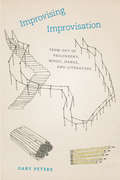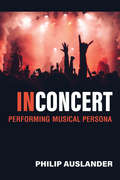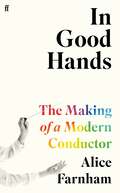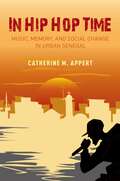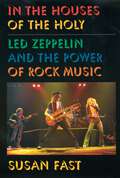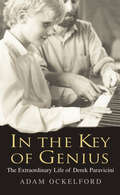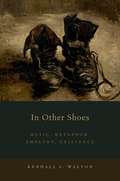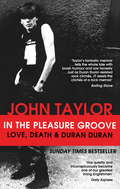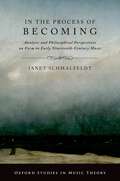- Table View
- List View
Improvising Fugue: A Method for Keyboard Artists
by John J. MortensenImprovising Fugue: A Method for Keyboard Artists is a guide for those who aspire to the highest levels of fluency as inventors of spontaneous music at the piano, fortepiano, harpsichord, organ, or digital keyboard. Written for professional performers, conservatory students, and devoted amateurs, this book leads the reader along the arduous journey from score dependency to improvisational freedom. Improvising Fugue begins with a comprehensive course in 18th century Italian partimento, the system of musicianship training that simultaneously strengthens improvisation, counterpoint, harmony, keyboard skills, and audiation. The reader then encounters fugue improvisation in a gradual, methodical, and rigorous manner. Every concept is accompanied by extensive and clear explanation, examples from music literature, and practical exercises. The book covers every aspect of fugue improvisation in depth, including subjects, countersubjects, tonal and real answers, episodes, presentations, pedal points, and stretti. Author John J. Mortensen draws on experience as a concert improviser on the international stage; the book's pragmatic, real-world instruction comes from a seasoned performer who knows firsthand exactly what is required to improvise fugues in the presence of a live audience.
Improvising Fugue: A Method for Keyboard Artists
by John J. MortensenImprovising Fugue: A Method for Keyboard Artists is a guide for those who aspire to the highest levels of fluency as inventors of spontaneous music at the piano, fortepiano, harpsichord, organ, or digital keyboard. Written for professional performers, conservatory students, and devoted amateurs, this book leads the reader along the arduous journey from score dependency to improvisational freedom. Improvising Fugue begins with a comprehensive course in 18th century Italian partimento, the system of musicianship training that simultaneously strengthens improvisation, counterpoint, harmony, keyboard skills, and audiation. The reader then encounters fugue improvisation in a gradual, methodical, and rigorous manner. Every concept is accompanied by extensive and clear explanation, examples from music literature, and practical exercises. The book covers every aspect of fugue improvisation in depth, including subjects, countersubjects, tonal and real answers, episodes, presentations, pedal points, and stretti. Author John J. Mortensen draws on experience as a concert improviser on the international stage; the book's pragmatic, real-world instruction comes from a seasoned performer who knows firsthand exactly what is required to improvise fugues in the presence of a live audience.
Improvising Improvisation: From Out of Philosophy, Music, Dance, and Literature
by Gary PetersThere is an ever-increasing number of books on improvisation, ones that richly recount experiences in the heat of the creative moment, theorize on the essence of improvisation, and offer convincing arguments for improvisation’s impact across a wide range of human activity. This book is nothing like that. In a provocative and at times moving experiment, Gary Peters takes a different approach, turning the philosophy of improvisation upside-down and inside-out. Guided by Kant, Hegel, Heidegger, and especially Deleuze—and exploring a range of artists from Hendrix to Borges—Peters illuminates new fundamentals about what, as an experience, improvisation truly is. As he shows, improvisation isn’t so much a genre, idiom, style, or technique—it’s a predicament we are thrown into, one we find ourselves in. The predicament, he shows, is a complex entwinement of choice and decision. The performativity of choice during improvisation may happen “in the moment,” but it is already determined by an a priori mode of decision. In this way, improvisation happens both within and around the actual moment, negotiating a simultaneous past, present, and future. Examining these and other often ignored dimensions of spontaneous creativity, Peters proposes a consistently challenging and rigorously argued new perspective on improvisation across an extraordinary range of disciplines.
Improvising Improvisation: From Out of Philosophy, Music, Dance, and Literature
by Gary PetersThere is an ever-increasing number of books on improvisation, ones that richly recount experiences in the heat of the creative moment, theorize on the essence of improvisation, and offer convincing arguments for improvisation’s impact across a wide range of human activity. This book is nothing like that. In a provocative and at times moving experiment, Gary Peters takes a different approach, turning the philosophy of improvisation upside-down and inside-out. Guided by Kant, Hegel, Heidegger, and especially Deleuze—and exploring a range of artists from Hendrix to Borges—Peters illuminates new fundamentals about what, as an experience, improvisation truly is. As he shows, improvisation isn’t so much a genre, idiom, style, or technique—it’s a predicament we are thrown into, one we find ourselves in. The predicament, he shows, is a complex entwinement of choice and decision. The performativity of choice during improvisation may happen “in the moment,” but it is already determined by an a priori mode of decision. In this way, improvisation happens both within and around the actual moment, negotiating a simultaneous past, present, and future. Examining these and other often ignored dimensions of spontaneous creativity, Peters proposes a consistently challenging and rigorously argued new perspective on improvisation across an extraordinary range of disciplines.
Improvising Improvisation: From Out of Philosophy, Music, Dance, and Literature
by Gary PetersThere is an ever-increasing number of books on improvisation, ones that richly recount experiences in the heat of the creative moment, theorize on the essence of improvisation, and offer convincing arguments for improvisation’s impact across a wide range of human activity. This book is nothing like that. In a provocative and at times moving experiment, Gary Peters takes a different approach, turning the philosophy of improvisation upside-down and inside-out. Guided by Kant, Hegel, Heidegger, and especially Deleuze—and exploring a range of artists from Hendrix to Borges—Peters illuminates new fundamentals about what, as an experience, improvisation truly is. As he shows, improvisation isn’t so much a genre, idiom, style, or technique—it’s a predicament we are thrown into, one we find ourselves in. The predicament, he shows, is a complex entwinement of choice and decision. The performativity of choice during improvisation may happen “in the moment,” but it is already determined by an a priori mode of decision. In this way, improvisation happens both within and around the actual moment, negotiating a simultaneous past, present, and future. Examining these and other often ignored dimensions of spontaneous creativity, Peters proposes a consistently challenging and rigorously argued new perspective on improvisation across an extraordinary range of disciplines.
Improvising Improvisation: From Out of Philosophy, Music, Dance, and Literature
by Gary PetersThere is an ever-increasing number of books on improvisation, ones that richly recount experiences in the heat of the creative moment, theorize on the essence of improvisation, and offer convincing arguments for improvisation’s impact across a wide range of human activity. This book is nothing like that. In a provocative and at times moving experiment, Gary Peters takes a different approach, turning the philosophy of improvisation upside-down and inside-out. Guided by Kant, Hegel, Heidegger, and especially Deleuze—and exploring a range of artists from Hendrix to Borges—Peters illuminates new fundamentals about what, as an experience, improvisation truly is. As he shows, improvisation isn’t so much a genre, idiom, style, or technique—it’s a predicament we are thrown into, one we find ourselves in. The predicament, he shows, is a complex entwinement of choice and decision. The performativity of choice during improvisation may happen “in the moment,” but it is already determined by an a priori mode of decision. In this way, improvisation happens both within and around the actual moment, negotiating a simultaneous past, present, and future. Examining these and other often ignored dimensions of spontaneous creativity, Peters proposes a consistently challenging and rigorously argued new perspective on improvisation across an extraordinary range of disciplines.
Improvising Improvisation: From Out of Philosophy, Music, Dance, and Literature
by Gary PetersThere is an ever-increasing number of books on improvisation, ones that richly recount experiences in the heat of the creative moment, theorize on the essence of improvisation, and offer convincing arguments for improvisation’s impact across a wide range of human activity. This book is nothing like that. In a provocative and at times moving experiment, Gary Peters takes a different approach, turning the philosophy of improvisation upside-down and inside-out. Guided by Kant, Hegel, Heidegger, and especially Deleuze—and exploring a range of artists from Hendrix to Borges—Peters illuminates new fundamentals about what, as an experience, improvisation truly is. As he shows, improvisation isn’t so much a genre, idiom, style, or technique—it’s a predicament we are thrown into, one we find ourselves in. The predicament, he shows, is a complex entwinement of choice and decision. The performativity of choice during improvisation may happen “in the moment,” but it is already determined by an a priori mode of decision. In this way, improvisation happens both within and around the actual moment, negotiating a simultaneous past, present, and future. Examining these and other often ignored dimensions of spontaneous creativity, Peters proposes a consistently challenging and rigorously argued new perspective on improvisation across an extraordinary range of disciplines.
Improvising Improvisation: From Out of Philosophy, Music, Dance, and Literature
by Gary PetersThere is an ever-increasing number of books on improvisation, ones that richly recount experiences in the heat of the creative moment, theorize on the essence of improvisation, and offer convincing arguments for improvisation’s impact across a wide range of human activity. This book is nothing like that. In a provocative and at times moving experiment, Gary Peters takes a different approach, turning the philosophy of improvisation upside-down and inside-out. Guided by Kant, Hegel, Heidegger, and especially Deleuze—and exploring a range of artists from Hendrix to Borges—Peters illuminates new fundamentals about what, as an experience, improvisation truly is. As he shows, improvisation isn’t so much a genre, idiom, style, or technique—it’s a predicament we are thrown into, one we find ourselves in. The predicament, he shows, is a complex entwinement of choice and decision. The performativity of choice during improvisation may happen “in the moment,” but it is already determined by an a priori mode of decision. In this way, improvisation happens both within and around the actual moment, negotiating a simultaneous past, present, and future. Examining these and other often ignored dimensions of spontaneous creativity, Peters proposes a consistently challenging and rigorously argued new perspective on improvisation across an extraordinary range of disciplines.
Improvision: Orphic Art in the Age of Jazz
by Simon Shaw-MillerCentral to the development of abstract art, in the early decades of the 20th century was the conception (most famously articulated by Walter Pater) that the most appropriate paradigm for non-figurative art was music. The assumption has always been that this model was most effectively understood as Western art music (classical music).However, the musical form that was abstract art's true twin is jazz, a music that originated with African Americans, but which had a profound impact on European artistic sensibilities. Both art forms share creative techniques of rhythm, groove, gesture and improvisation. This book sets out to theorize affinities and connections between, and across, two seemingly diverse cultural phenomena.
Improvision: Orphic Art in the Age of Jazz
by Simon Shaw-MillerCentral to the development of abstract art, in the early decades of the 20th century was the conception (most famously articulated by Walter Pater) that the most appropriate paradigm for non-figurative art was music. The assumption has always been that this model was most effectively understood as Western art music (classical music).However, the musical form that was abstract art's true twin is jazz, a music that originated with African Americans, but which had a profound impact on European artistic sensibilities. Both art forms share creative techniques of rhythm, groove, gesture and improvisation. This book sets out to theorize affinities and connections between, and across, two seemingly diverse cultural phenomena.
The In-Between in Javanese Performing Arts: History and Myth, Interculturalism and Interreligiosity (Music / Culture)
by SumarsamThis book is the first comprehensive overview of Javanese performing arts from their origins to their dynamic present. Renowned scholar and musician Sumarsam draws from a lifetime of immersion in both wayang and gamelan to guide readers through the concept of the "in-between," revealing how the interplay of dualisms—myth and history, sacred and secular, personal and cultural—forms the bedrock of Javanese performance. Rigorously researched historical case studies reveal the intricate relationship between histories and mythologies in Java. Wayang, accompanied by gamelan, is a multimedia performance imbued with rich historical, aesthetic, religious, and emotional associations. Sumarsam delves into this intricate, profound, and ever-evolving art form, exploring its diverse manifestations and venues, from courtly village entertainment-cum-ritual to palace-based aesthetic expressions of cultural proficiency; from coastal mercantile entrepots to the verdant wet rice terraces of Java; from colonial plantation and textile factory cultures to communities centered around contemporary industrial estates and creative economy initiatives. An essential resource for scholars, musicians, and enthusiasts of wayang and gamelan, The In-Between in Javanese Performing Arts offers an unparalleled immersion into the heart of traditional Javanese performing arts, revealing their profound impact on Javanese culture, identity, and artistic expression.
In-Between Worlds: Performing [as] Bauls in an Age of Extremism (Routledge Advances in Theatre & Performance Studies)
by Sukanya ChakrabartiThis book examines the performance of Bauls ‘folk’ performers from Bengal, in the context of a rapidly globalizing Indian economy and against the backdrop of extreme nationalistic discourses. Recognizing their scope beyond the musical and cultural realm, Sukanya Chakrabarti engages in discussing the subversive and transformational potency of Bauls and their performances. In-Between Worlds argues that the Bauls through their musical, spiritual, and cultural performances offer ‘joy’ and ‘spirituality,’ thus making space for what Dr. Ambedkar in his famous 1942 speech had identified as ‘reclamation of human personality’. Chakrabarti destabilizes the category of ‘folk’ as a fixed classification or an origin point, and fractures homogeneous historical representations of the Baul as a ‘folk’ performer and a wandering mendicant exposing the complex heterogeneity that characterizes this group. Establishing ‘folk-ness’ as a performance category, and ‘folk festivals’ as sites of performing ‘folk-ness,’ contributing to a heritage industry that thrives on imagined and recreated nostalgia, Chakrabarti examines different sites that produce varied performative identities of Bauls, probing the limits of such categories while simultaneously advocating for polyvocality and multifocality. While this project has grounded itself firmly in performance studies, it has borrowed extensively from fields of postcolonial studies and subaltern histories, literature, ethnography and ethnomusicology, and cosmopolitan studies.
In-Between Worlds: Performing [as] Bauls in an Age of Extremism (Routledge Advances in Theatre & Performance Studies)
by Sukanya ChakrabartiThis book examines the performance of Bauls ‘folk’ performers from Bengal, in the context of a rapidly globalizing Indian economy and against the backdrop of extreme nationalistic discourses. Recognizing their scope beyond the musical and cultural realm, Sukanya Chakrabarti engages in discussing the subversive and transformational potency of Bauls and their performances. In-Between Worlds argues that the Bauls through their musical, spiritual, and cultural performances offer ‘joy’ and ‘spirituality,’ thus making space for what Dr. Ambedkar in his famous 1942 speech had identified as ‘reclamation of human personality’. Chakrabarti destabilizes the category of ‘folk’ as a fixed classification or an origin point, and fractures homogeneous historical representations of the Baul as a ‘folk’ performer and a wandering mendicant exposing the complex heterogeneity that characterizes this group. Establishing ‘folk-ness’ as a performance category, and ‘folk festivals’ as sites of performing ‘folk-ness,’ contributing to a heritage industry that thrives on imagined and recreated nostalgia, Chakrabarti examines different sites that produce varied performative identities of Bauls, probing the limits of such categories while simultaneously advocating for polyvocality and multifocality. While this project has grounded itself firmly in performance studies, it has borrowed extensively from fields of postcolonial studies and subaltern histories, literature, ethnography and ethnomusicology, and cosmopolitan studies.
In Concert: Performing Musical Persona
by Philip AuslanderThe conventional way of understanding what musicians do as performers is to treat them as producers of sound; some even argue that it is unnecessary to see musicians in performance as long as one can hear them. But musical performance, counters Philip Auslander, is also a social interaction between musicians and their audiences, appealing as much to the eye as to the ear. In Concert: Performing Musical Persona he addresses not only the visual means by which musicians engage their audiences through costume and physical gesture, but also spectacular aspects of performance such as light shows. Although musicians do not usually enact fictional characters on stage, they nevertheless present themselves to audiences in ways specific to the performance situation. Auslander’s term to denote the musician’s presence before the audience is musical persona. While presence of a musical persona may be most obvious within rock and pop music, the book’s analysis extends to classical music, jazz, blues, country, electronic music, laptop performance, and music made with experimental digital interfaces. The eclectic group of performers discussed include the Beatles, Miles Davis, Keith Urban, Lady Gaga, Nicki Minaj, Frank Zappa, B. B. King, Jefferson Airplane, Virgil Fox, Keith Jarrett, Glenn Gould, and Laurie Anderson.
In Defense of Don Giovanni: A Feminist Mythobiography
by Luisa PasseriniWho wants to champion the figure of Don Giovanni in the time of Harvey Weinstein and #MeToo? Don Giovanni is a rapist, murderer, serial seducer, and liar. Can he ever be held up as a role model or seen as a figure to be enjoyed? This is the task that the eminent Italian historian and lifelong feminist, Luisa Passerini, sets for herself in In Defense of Don Giovanni. As she developed the long arc of her distinguished career, Don Giovanni surprisingly became not only her role model but also a secret object of research. Taking her method from oral history, Passerini creates a series of characters with whom she discusses the forms and incarnations of the myth of Don Giovanni across time, from its first appearance in early medieval Spain and Commedia dell’Arte to its many European variations and its transposition to the colonial and postcolonial world in the Middle East, the Americas, and Africa. Pivoting round Don Giovanni’s best known incarnation in Mozart’s opera, Passerini and her interlocutors meet in different locations from Venice and Bern to Paris and Turin. They discuss plays, films, and operas and talk about art, novels, and psychoanalytic interpretations of the myth while also sharing their own life stories, in which Don Giovanni often plays a part that is, by turns, destructive, mischievous, and full of the joy of life. From his early beginnings in the Iberian Peninsula to recent analysis of the sexuality of colonial conquest and postcolonial revenge and return, Don Giovanni shape-shifts between rapacious hypermasculinity, comic trickster, and morally vacuous loser whose annoyingly persistent nemesis Don Ottavio emerges as an alternative and ultimately better object of desire. As she tracks Don Giovanni’s image across the world and through the centuries, however, Passerini comes to see that it also plays another role, that of a mirror, in which women can see themselves emerge as individuals with their own life force.
In Good Hands: The Making of a Modern Conductor
by Alice FarnhamPassing the Baton: Conducting in the 21st Century explores the ways in which gender, culture and socio-economic status influence a conductor's language, career, confidence and even their body. With her own personal story at the heart, leading conductor Alice Farnham interviews conductors - both men and women - at different stages in their career, looking at what it takes to become a conductor. Alice has set many women on a path to the profession, and her book gives a particular voice to female conductors, what it takes to succeed, and just what the job entails. This is not a handbook for conducting, though it describes the job to the layman. A book for all music lovers, professional musicians and anyone interested in leadership.
In Hip Hop Time: Music, Memory, and Social Change in Urban Senegal
by Catherine M. AppertIn the twenty-first century, Senegalese hip hop--"Rap Galsen"--has reverberated throughout the world as an exemplar of hip hop resistance in its mobilization against government corruption during a series of tumultuous presidential elections. Yet Senegalese hip hop's story goes beyond resistance; it is a story of globalization, of diasporic movement and memory, of imagined African pasts and contemporary African realities, and of urbanization and the banality of socio-economic struggle. At particular moments in Rap Galsen's history, origin narratives linked hip hop to a mythologized Africa through the sounds of indigenous oralities. At other times, contrasting narratives highlighted hip hop's equally mythologized roots in the postindustrial U.S. inner city and African American experience. As Senegalese youth engage these globally circulating narratives, hip hop performance and its stories negotiate their place in a rapidly changing world. In Hip Hop Time explores this relationship between popular music and social change, framing Senegalese hip hop as a musical movement deeply tied to both indigenous performance practices and changing social norms in urban Africa. Author Catherine Appert takes us from Senegalese hip hop's beginnings among cosmopolitan youth in Dakar's affluent neighborhoods in the 1980s, to its spread throughout the city's ghettoized working class neighborhoods in the mid- to late-'90s, and into the present day, where political activism and hip hop musicality vie for position in local and global arenas. An ethnography of the inextricability of musical and social meaning in hip hop practice, In Hip Hop Time charts new intellectual territory in the scholarship of African and global hip hop.
IN HIP HOP TIME C: Music, Memory, and Social Change in Urban Senegal
by Catherine M. AppertIn the twenty-first century, Senegalese hip hop--"Rap Galsen"--has reverberated throughout the world as an exemplar of hip hop resistance in its mobilization against government corruption during a series of tumultuous presidential elections. Yet Senegalese hip hop's story goes beyond resistance; it is a story of globalization, of diasporic movement and memory, of imagined African pasts and contemporary African realities, and of urbanization and the banality of socio-economic struggle. At particular moments in Rap Galsen's history, origin narratives linked hip hop to a mythologized Africa through the sounds of indigenous oralities. At other times, contrasting narratives highlighted hip hop's equally mythologized roots in the postindustrial U.S. inner city and African American experience. As Senegalese youth engage these globally circulating narratives, hip hop performance and its stories negotiate their place in a rapidly changing world. In Hip Hop Time explores this relationship between popular music and social change, framing Senegalese hip hop as a musical movement deeply tied to both indigenous performance practices and changing social norms in urban Africa. Author Catherine Appert takes us from Senegalese hip hop's beginnings among cosmopolitan youth in Dakar's affluent neighborhoods in the 1980s, to its spread throughout the city's ghettoized working class neighborhoods in the mid- to late-'90s, and into the present day, where political activism and hip hop musicality vie for position in local and global arenas. An ethnography of the inextricability of musical and social meaning in hip hop practice, In Hip Hop Time charts new intellectual territory in the scholarship of African and global hip hop.
In The Key of Genius: The Extraordinary Life of Derek Paravicini
by Adam OckelfordDerek Paravicini is blind, can't tell his right hand from his left and needs round-the-clock care. But he has an extremely rare gift - he is a musical prodigy with perfect pitch whose piano-playing has thrilled audiences at venues from Ronnie Scott's to Las Vegas, the Barbican to Buckingham Palace. Born prematurely, Derek remained in hospital for three months and technically 'died' several times before he was finally strong enough to go home. It was not long before his blindness became apparent and later it became clear that he had severe learning difficulties and autism. Desperately trying to find something to engage and stimulate baby Derek, his nanny discovered a toy organ and put it down in front of him. Miraculously, Derek taught himself to play. Music proved to be an outlet for expressing himself and communicating with others - his way of dealing with a strange and confusing world.
In My Life: A Music Memoir
by Alan JohnsonFrom being transported by the sound of 'True Love' by Bing Crosby and Grace Kelly on the radio, as a small child living in condemned housing in ungentrified West London in the late 1950s, to going out to work as a postman humming 'Watching the Detectives' by Elvis Costello in 1977, Alan Johnson's life has always had a musical soundtrack. In fact music hasn't just accompanied his life, it's been an integral part of it.In the bestselling and award-winning tradition of This Boy, In My Life vividly transports us to a world that is no longer with us - a world of Dansettes and jukeboxes, of heartfelt love songs and heart-broken ballads, of smoky coffee shops and dingy dance halls. From Bob Dylan to David Bowie, from Lonnie Donnegan to Bruce Springsteen, all of Alan's favourites are here. As are, of course, his beloved Beatles, whom he has worshipped with undying admiration since 1963.But this isn't just a book about music. In My Life adds a fourth dimension to the story of Alan Johnson the man.
In Other Shoes: Music, Metaphor, Empathy, Existence
by Kendall L. WaltonIn fifteen essays-one new, two newly revised and expanded, three with new postscripts-Kendall L. Walton wrestles with philosophical issues concerning music, metaphor, empathy, existence, fiction, and expressiveness in the arts. These subjects are intertwined in striking and surprising ways. By exploring connections among them, appealing sometimes to notions of imagining oneself in shoes different from one's own, Walton creates a wide-ranging mosaic of innovative insights.
In Other Shoes: Music, Metaphor, Empathy, Existence
by Kendall L. WaltonIn fifteen essays-one new, two newly revised and expanded, three with new postscripts-Kendall L. Walton wrestles with philosophical issues concerning music, metaphor, empathy, existence, fiction, and expressiveness in the arts. These subjects are intertwined in striking and surprising ways. By exploring connections among them, appealing sometimes to notions of imagining oneself in shoes different from one's own, Walton creates a wide-ranging mosaic of innovative insights.
In The Pleasure Groove: Love, Death and Duran Duran
by John TaylorWith Duran Duran, John Taylor has created some of the greatest songs of our time. From the disco dazzle of debut single 'Planet Earth' right up to their latest number one album All You Need is Now, Duran Duran has always had the power to sweep the world onto its feet.It's been a ride - and for John in particular, the ride has been wild, thrilling... and dangerous. Now, for the first time, he tells his incredible story - a tale of dreams fulfilled, lessons learned and demons conquered. A shy only child, Nigel John Taylor wasn't an obvious candidate for pop stardom and frenzied girl panic. But when he ditched his first name and picked up a bass guitar, everything changed. John formed Duran Duran with his friend Nick Rhodes in the spring of 1978, and they were soon joined by Roger Taylor, then Andy Taylor and finally Simon Le Bon. Together they were an immediate, massive global success story, their pictures on millions of walls, every single a worldwide hit. In his frank, compelling autobiography, John recounts the highs - hanging out with icons like Bowie, Warhol and even James Bond; dating Vogue models and driving fast cars - all the while playing hard with the band he loved. But he faced tough battles ahead - troubles that brought him to the brink of self-destruction - before turning his life around.Told with humour, honesty and hard-won wisdom, and packed with exclusive pictures, In the Pleasure Groove is a fascinating, irresistible portrait of a man who danced into the fire... and came through the other side.
IN PROC BECOM ANALY PHIL OXSMT C: Analytic and Philosophical Perspectives on Form in Early Nineteenth-Century Music (Oxford Studies in Music Theory)
by Janet SchmalfeldtWith their insistence that form is a dialectical process in the music of Beethoven, Theodor Adorno and Carl Dahlhaus emerge as the guardians of a long-standing critical tradition in which Hegelian concepts have been brought to bear on the question of musical form. Janet Schmalfeldt's ground-breaking account of the development of this Beethoven-Hegelian tradition restores to the term "form" some of its philosophical associations in the early nineteenth century, when profound cultural changes were yielding new relationships between composers and their listeners, and when music itself-in particular, instrumental music-became a topic for renewed philosophical investigation. Precedents for Adorno's and Dahlhaus's concept of form as process arise in the Athenäum Fragments of Friedrich Schlegel and in the Encyclopaedia Logic of Hegel. The metaphor common to all these sources is the notion of becoming; it is the idea of form coming into being that this study explores in respect to music by Beethoven, Schubert, Mendelssohn, Chopin, and Schumann. A critical assessment of Dahlhaus's preoccupation with the opening of Beethoven's "Tempest" Sonata serves as the author's starting point for the translation of philosophical ideas into music-analytical terms-ones that encourage listening "both forward and backward," as Adorno has recommended. Thanks to the ever-growing familiarity of late eighteenth-century audiences with formal conventions, composers could increasingly trust that performers and listeners would be responsive to striking formal transformations. The author's analytic method strives to capture the dynamic, quasi-narrative nature of such transformations, rather than only their end results. This experiential approach to the perception of form invites listeners and especially performers to participate in the interpretation of processes by which, for example, a brooding introduction-like opening must inevitably become the essential main theme in Schubert's Sonata, Op. 42, or in which tremendous formal expansions in movements by Mendelssohn offer a dazzling opportunity for multiple retrospective reinterpretations. Above all, In the Process of Becoming proposes new ways of hearing beloved works of the romantic generation as representative of their striving for novel, intensely self-reflective modes of communication.

